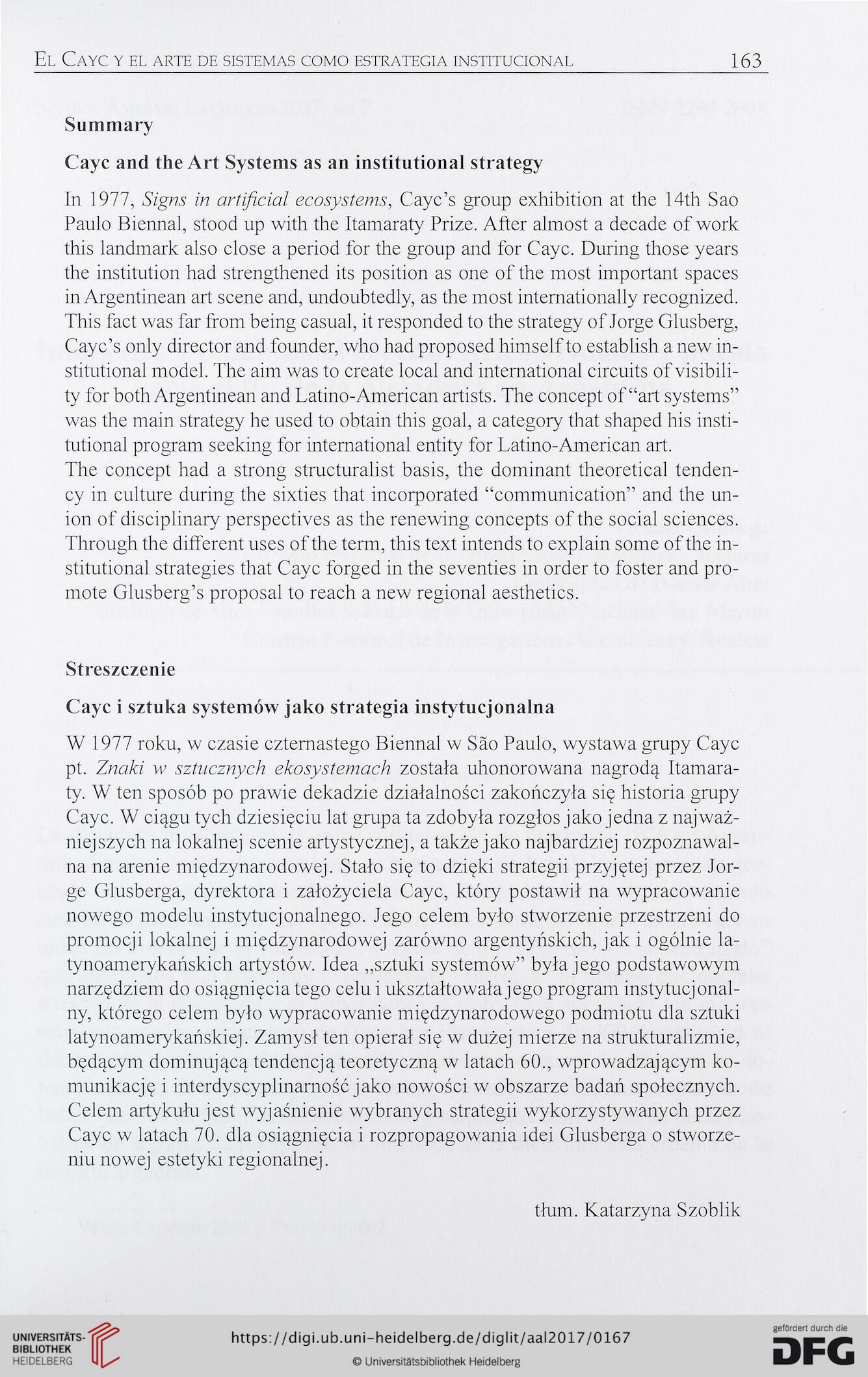El Cayc y el arte de sistemas como estrategia institucional
163
Summary
Cayc and the Art Systems as an institutional strategy
In 1977, Signs in artificial ecosystems, Cayc’s group exhibition at the 14th Sao
Paulo Biennal, stood up with the Itamaraty Prize. After almost a decade of work
this landmark also close a period for the group and for Cayc. During those years
the institution had strengthened its position as one of the most important spaces
in Argentinean art scene and, undoubtedly, as the most internationally recognized.
This fact was far from being casual, it responded to the strategy of Jorge Glusberg,
Cayc’s only director and founder, who had proposed himself to establish a new in-
stitutional model. The aim was to create local and international circuits of visibili-
ty for both Argentinean and Latino-American artists. The concept of “art systems”
was the main strategy he used to obtain this goal, a category that shaped his insti-
tutional program seeking for international entity for Latino-American art.
The concept had a strong structuralist basis, the dominant theoretical tenden-
cy in culture during the sixties that incorporated “communication” and the un-
ion of disciplinary perspectives as the renewing concepts of the social sciences.
Through the different uses of the term, this text intends to explain some of the in-
stitutional strategies that Cayc forged in the seventies in order to foster and pro-
mote Glusberg’s proposal to reach a new regional aesthetics.
Streszczenie
Cayc i sztuka systemów jako strategia instytucjonalna
W 1977 roku, w czasie czternastego Biennal w Sao Paulo, wystawa grupy Cayc
pt. Znaki w sztucznych ekosystemach została uhonorowana nagrodą Itamara-
ty. W ten sposób po prawie dekadzie działalności zakończyła się historia grupy
Cayc. W ciągu tych dziesięciu lat grupa ta zdobyła rozgłos jako jedna z najważ-
niejszych na lokalnej scenie artystycznej, a także jako najbardziej rozpoznawal-
na na arenie międzynarodowej. Stało się to dzięki strategii przyjętej przez Jor-
ge Glusberga, dyrektora i założyciela Cayc, który postawił na wypracowanie
nowego modelu instytucjonalnego. Jego celem było stworzenie przestrzeni do
promocji lokalnej i międzynarodowej zarówno argentyńskich, jak i ogólnie la-
tynoamerykańskich artystów. Idea „sztuki systemów” była jego podstawowym
narzędziem do osiągnięcia tego celu i ukształtowała jego program instytucjonal-
ny, którego celem było wypracowanie międzynarodowego podmiotu dla sztuki
latynoamerykańskiej. Zamysł ten opierał się w dużej mierze na strukturalizmie,
będącym dominującą tendencją teoretyczną w latach 60., wprowadzającym ko-
munikację i interdyscyplinarność jako nowości w obszarze badań społecznych.
Celem artykułu jest wyjaśnienie wybranych strategii wykorzystywanych przez
Cayc w latach 70. dla osiągnięcia i rozpropagowania idei Glusberga o stworze-
niu nowej estetyki regionalnej.
tłum. Katarzyna Szoblik
163
Summary
Cayc and the Art Systems as an institutional strategy
In 1977, Signs in artificial ecosystems, Cayc’s group exhibition at the 14th Sao
Paulo Biennal, stood up with the Itamaraty Prize. After almost a decade of work
this landmark also close a period for the group and for Cayc. During those years
the institution had strengthened its position as one of the most important spaces
in Argentinean art scene and, undoubtedly, as the most internationally recognized.
This fact was far from being casual, it responded to the strategy of Jorge Glusberg,
Cayc’s only director and founder, who had proposed himself to establish a new in-
stitutional model. The aim was to create local and international circuits of visibili-
ty for both Argentinean and Latino-American artists. The concept of “art systems”
was the main strategy he used to obtain this goal, a category that shaped his insti-
tutional program seeking for international entity for Latino-American art.
The concept had a strong structuralist basis, the dominant theoretical tenden-
cy in culture during the sixties that incorporated “communication” and the un-
ion of disciplinary perspectives as the renewing concepts of the social sciences.
Through the different uses of the term, this text intends to explain some of the in-
stitutional strategies that Cayc forged in the seventies in order to foster and pro-
mote Glusberg’s proposal to reach a new regional aesthetics.
Streszczenie
Cayc i sztuka systemów jako strategia instytucjonalna
W 1977 roku, w czasie czternastego Biennal w Sao Paulo, wystawa grupy Cayc
pt. Znaki w sztucznych ekosystemach została uhonorowana nagrodą Itamara-
ty. W ten sposób po prawie dekadzie działalności zakończyła się historia grupy
Cayc. W ciągu tych dziesięciu lat grupa ta zdobyła rozgłos jako jedna z najważ-
niejszych na lokalnej scenie artystycznej, a także jako najbardziej rozpoznawal-
na na arenie międzynarodowej. Stało się to dzięki strategii przyjętej przez Jor-
ge Glusberga, dyrektora i założyciela Cayc, który postawił na wypracowanie
nowego modelu instytucjonalnego. Jego celem było stworzenie przestrzeni do
promocji lokalnej i międzynarodowej zarówno argentyńskich, jak i ogólnie la-
tynoamerykańskich artystów. Idea „sztuki systemów” była jego podstawowym
narzędziem do osiągnięcia tego celu i ukształtowała jego program instytucjonal-
ny, którego celem było wypracowanie międzynarodowego podmiotu dla sztuki
latynoamerykańskiej. Zamysł ten opierał się w dużej mierze na strukturalizmie,
będącym dominującą tendencją teoretyczną w latach 60., wprowadzającym ko-
munikację i interdyscyplinarność jako nowości w obszarze badań społecznych.
Celem artykułu jest wyjaśnienie wybranych strategii wykorzystywanych przez
Cayc w latach 70. dla osiągnięcia i rozpropagowania idei Glusberga o stworze-
niu nowej estetyki regionalnej.
tłum. Katarzyna Szoblik




